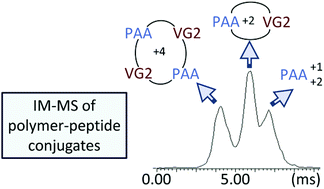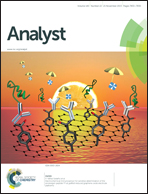Top-down mass spectrometry of hybrid materials with hydrophobic peptide and hydrophilic or hydrophobic polymer blocks†
Abstract
A multidimensional mass spectrometry (MS) methodology is introduced for the molecular level characterization of polymer–peptide (or polymer–protein) copolymers that cannot be crystallized or chromatographically purified. It encompasses electrospray ionization (ESI) or matrix-assisted laser desorption ionization (MALDI) coupled with mass analysis, tandem mass spectrometry (MS2) and gas-phase separation by ion mobility mass spectrometry (IM-MS). The entire analysis is performed in the mass spectrometer (“top-down” approach) within milliseconds and with high sensitivity, as demonstrated for hybrid materials composed of hydrophobic poly(tert-butyl acrylate) (PtBA) or hydrophilic poly(acrylic acid) (PAA) blocks tethered to the hydrophobic decapeptide VPGVGVPGVG (VG2) via triazole linkages. The composition of the major products can be rapidly surveyed by MALDI-MS and MS2. For a more comprehensive characterization, the ESI-IM-MS (and MS2) combination is more suitable, as it separates the hybrid materials based on their unique charges and shapes from unconjugated polymer and partially hydrolyzed products. Such separation is essential for reducing spectral congestion, deconvoluting overlapping compositions and enabling straightforward structural assignments, both for the hybrid copolymers as well as the polymer and peptide reactants. The IM dimension also permits the measurement of collision cross-sections (CCSs), which reveal molecular architecture. The MS and MS2 spectra of the mobility separated ions conclusively showed that [PtBA-VG2]m and [PAA-VG2]m chains with the expected compositions and sequences were formed. Single and double copolymer blocks (m = 1–2) could be detected. Further, the CCSs of the hybrids, which were prepared via azide/alkyne cycloadditions, confirmed the formation of macrocyclic structures. The top-down methodology described would be particularly useful for the detection and identification of peptide/protein–polymer conjugates which are increasingly used in biomedical and pharmaceutical applications.

- This article is part of the themed collection: Ion Mobility Mass Spectrometry

 Please wait while we load your content...
Please wait while we load your content...